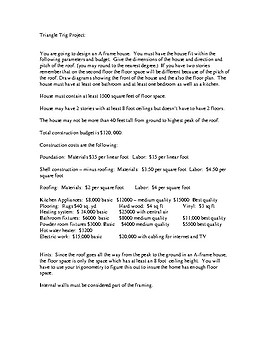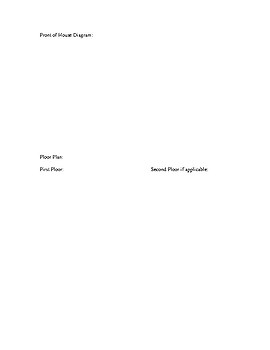Design an A Frame House
BJ Chadwick
2 Followers
Grade Levels
7th - 12th
Subjects
Resource Type
Standards
CCSSMP1
Formats Included
- PDF
Pages
3 pages
BJ Chadwick
2 Followers
Description
A project for any student who has learned triangle trigonometry. Students design an A frame house to certain specifications and within a certain budget. Costs for various aspects of the home are given. Students must calculate floor space, framing, roofing, foundation size, etc. This project makes a good multiple day homework assignment. It is recommended that the teacher go over problems in class that relate to the specific tasks needed to complete this project.
The project could be done by advanced students in middle school using similar triangles but is designed for use with trigonometric ratios.
The project could be done by advanced students in middle school using similar triangles but is designed for use with trigonometric ratios.
Total Pages
3 pages
Answer Key
N/A
Teaching Duration
1 Week
Report this resource to TPT
Reported resources will be reviewed by our team. Report this resource to let us know if this resource violates TPT’s content guidelines.
Standards
to see state-specific standards (only available in the US).
CCSSMP1
Make sense of problems and persevere in solving them. Mathematically proficient students start by explaining to themselves the meaning of a problem and looking for entry points to its solution. They analyze givens, constraints, relationships, and goals. They make conjectures about the form and meaning of the solution and plan a solution pathway rather than simply jumping into a solution attempt. They consider analogous problems, and try special cases and simpler forms of the original problem in order to gain insight into its solution. They monitor and evaluate their progress and change course if necessary. Older students might, depending on the context of the problem, transform algebraic expressions or change the viewing window on their graphing calculator to get the information they need. Mathematically proficient students can explain correspondences between equations, verbal descriptions, tables, and graphs or draw diagrams of important features and relationships, graph data, and search for regularity or trends. Younger students might rely on using concrete objects or pictures to help conceptualize and solve a problem. Mathematically proficient students check their answers to problems using a different method, and they continually ask themselves, "Does this make sense?" They can understand the approaches of others to solving complex problems and identify correspondences between different approaches.




